Submission to the Productivity Commission Inquiry into Competition in the Financial System 3. Assessing Competition in the Financial System
- Download 970KB
This section takes a system-wide perspective of competition. It examines the broad trends in the sector and characteristics that have a bearing on competition. It then notes challenges in assessing competition before presenting available indicators for Australia.
Long-term trends
The Australian financial system has changed significantly since the period of financial deregulation in the 1980s. This is evident in two important trends.[2] First, the financial sector has increased in importance, with assets rising from around the level of annual GDP prior to the period of deregulation, to be approaching four times GDP today (Graph 1). Second, the institutional structure of the financial system has changed, with the importance of banks steadily growing. Today banks account for more than half of the total assets of the financial system, up from one-third in 1980, and their lending accounts for around 90 per cent of total credit (Graph 2). Over the same period, the relative importance of non-bank financial intermediaries has declined (including credit unions, building societies and registered financial corporations – institutions that grew strongly prior to the 1980s, partly as a result of being subject to fewer regulations than banks).


There has been a considerable rationalisation of credit unions and building societies (which are now prudentially regulated as ADIs), associated with regulatory changes and competitive pressures. This rationalisation has occurred through a number of mergers and acquisitions within the sector, as well as a number of credit unions and building societies converting to mutual banks. Today the share of financial intermediation outside the prudentially regulated sectors is very small.
This section focuses predominantly on competition in the banking system, but, as will be discussed, competitive outcomes can be significantly influenced by competition from outside the sector.
Characteristics of the finance sector
Competition can generally be expected to deliver a range of benefits, including: better allocation of resources; more technically efficient and low-cost production; better quality and variety of services; greater adaptability and, in the finance sector's case, greater availability of credit. However, there are a number of characteristics and behaviours that have a bearing on the level and nature of competition in the finance sector. Some of the more important are outlined below.
- Economies of scale. Large institutions can operate more efficiently than smaller institutions in some regards, for instance by spreading fixed costs (e.g. branch networks, information technology (IT) and investment in brand recognition) across a larger asset or revenue base. This means that a small number of large banks might be an efficient, low-cost market structure (Jayaratne, J and P 1998). Scale also helps the major banks achieve lower funding costs because they are more diversified and, therefore, less risky and they are better recognised by potential investors resulting in debt that is more liquid. There is also the perception of an implicit government guarantee on the basis that they could be ‘too big to fail’. The higher the fixed costs in a particular area of business (e.g. SME credit assessment capabilities or research and development), the greater the advantage to scale.
- Economies of scope and product bundling. Institutions can also reduce costs by offering a number of related products. The major banks provide a full suite of intermediation and transactional products across a wide range of customer types. They have also diversified into mortgage broking, stockbroking, wealth management and advisory services, in part to take advantage of shared distribution channels. This diversification is accompanied by cross-selling and the bundling of products into a package for customers, for example an offset account and a credit card with a home loan or card acquiring services with a business loan. While bundling can be beneficial for customers, it can also reduce competition in individual product markets by making customers less willing to switch providers, particularly if there is a degree of cross-subsidisation between products.
-
Information problems. One of the main roles played by financial intermediaries is to efficiently gather information about the credit risk of potential borrowers. However, their knowledge of the borrower increases with the length and breadth of the relationship between the institution and the borrower (Dell'Ariccia and Marquez 2001). The borrower may therefore find it difficult to switch to another institution that has less information and might be less willing to lend. The challenges intermediaries face with assessing credit risk are particularly acute for SME loans. Assessment of SME loans requires evaluations across a large variety of markets, business models and other idiosyncratic factors, while available information will be limited compared with larger firms. Initiatives that make information about the borrower more readily available to other potential lenders (such as those on comprehensive credit reporting and open data) therefore have the potential to increase competition.
Another form of information problem is that customers might not have full information about the products and prices offered by other providers, preventing them from making an informed choice. For instance, transparency in the small business and home loan markets can be poor given the prevalence of unadvertised discounts to the standard variable rate, in many cases negotiated directly. Under these circumstances a customer will have difficulty determining the competitive price without incurring large search costs.
- Switching costs. The perceived cost of switching between financial institutions limits competition. Costs include searching for a suitable new provider, proving identity to the new institution and redirecting existing payment arrangements. Product bundling and information problems also make switching more difficult.
- Differential pricing between customers. Institutions take advantage of a lack of transparency or switching costs to charge different customers different prices, regardless of the cost of providing the service or the risks involved. It is common to provide lower loan pricing or higher deposit pricing to new customers than established customers on the assumption that established customers might be less informed or unwilling to switch. Examples are ‘honeymoon’ mortgage rates, reduced rates on credit card balance transfers and bonus interest rates offered for an initial period on new deposit accounts. In this case, established and less mobile customers are subsidising low margins (or loss leaders) for new customers.
A further important feature of the finance sector is that it carries inherent risks and vulnerabilities, which, as demonstrated by the global financial crisis, can have a large negative effect on the real economy if not managed well. Competitive forces can aggravate these vulnerabilities if they encourage a weakening of lending standards (Berger, Klapper and Turk-Ariss 2009). Prudential regulation can address this effect by constraining banks' behaviour (Agoraki, Delis and Pasiouras 2011), and in doing so may place some constraints on competition. Given the ability of regulatory requirements to moderate the effect of increased competition on lending standards, it is reasonable to expect that well-considered enhancements to competition are likely to be sustainable (i.e. not offset by an increase in risks). Nonetheless, the broader effects of measures to promote competition should be considered.
Challenges in assessing competition
There are a number of challenges in making an assessment of competition in the financial system. One is that competition tends to be procyclical. In times of optimism, new competitors are attracted to the market by the expectation of high returns in an environment where demand is strong. Innovation is likely also to be strong and the market share of established players will be eroded. A tendency to underprice risk at such times often contributes to this dynamic. However, this level of competition tends not to be sustainable in more challenging times, resulting in a period of consolidation. For instance, new entry and strong competition in the housing credit market prior to the financial crisis resulted in an increasing market share for smaller players up until 2008. However, they were unable to maintain that share in the more difficult market conditions that followed.
This period also highlights the fact that the locus of competition can change with the financial cycle. As competition for lending eased during the crisis, competition strengthened in deposit markets in response to tighter funding conditions. An assessment of competition at any point in time should be mindful of these dynamics.
A number of additional challenges arise when seeking to examine specific markets:
- Suitably defining the market in which parties compete. For instance, the market for loans to large corporates is part of a broader market for finance with clearly available non-intermediated alternatives. Similarly, the market for deposits as an investment (rather than for transactional purposes) is part of a broader investment market, including superannuation, investment funds and direct investment in securities or higher-risk options such as shares or property.
- Banks' abilities to substitute fee and non-fee income. For example, banks might compete for housing loans by waiving application fees rather than lowering interest rates, making it difficult to assess competition on interest rates alone. A bank's revenue on a credit card product can include interest paid by cardholders, fees paid by cardholders (offset by any rewards paid) and fees paid indirectly by merchants, all of which can be rebalanced to maximise the profitability of the product.
- Isolating competition effects in lending and pricing. Lending volumes and interest rates contain information about risk and liquidity, as well as competition. These can vary over time and across jurisdictions; disentangling these effects can be challenging.
Competition indicators for the Australian banking system
This section considers a range of indicators that could provide some insights on competition in the financial system, including concentration, operational efficiency, profitability and margins.
Concentration
A common starting point for considering competition is the level of concentration within a market.
Australia has always had a fairly concentrated banking system (Graph 3). Through the 1960s and 1970s, the major banking groups, of which there were up to eight, accounted for around 80 per cent of banking assets in Australia. This share declined to around 65 per cent following deregulation and the entry of foreign banks in the mid 1980s. It remained around this level until the global financial crisis when the share of the major banks (which had been reduced to four through consolidation) rose back to around 80 per cent.
This level of concentration is high relative to some jurisdictions, but is also not unusual internationally (Graph 4). For example, the five largest Australian banks hold around 80 per cent of total bank loans in Australia, which is similar to banking systems in Canada, the Netherlands and Sweden.


Across individual market segments, the major banks typically account for around three-quarters of the Australian market, but there is some noticeable variation (Table 1). In particular they hold lower shares of the market for large business loans (where foreign banks are more active) and personal loans (where vehicle finance companies hold a significant share). By contrast, there are fewer competitors in the small business loan market, where the majors currently hold an 83 per cent share.
Concentration in individual markets has also varied over time. Similar to the pattern discussed above, it tended to fall in the lead-up to the crisis and rise afterwards. Concentration has subsequently declined modestly in the housing loan, business loan and card acquiring markets, while it has fallen more noticeably in the market for large business loans.
| 2003(a) Per cent | 2008 Per cent | 2014 Per cent | 2016/17 Per cent | |
|---|---|---|---|---|
| Personal deposits | 75 | 73 | 76 | 77 |
| Personal loans | 51 | 51 | 60 | 62 |
| Housing loans | 70 | 66 | 78 | 77 |
| Business loans | ||||
| – small business | 75 | 68 | 85 | 83 |
| – large business | 67 | 63 | 70 | 66 |
| Card transactions | ||||
| – credit issuing | n.a. | 72 | 75 | 76 |
| – acquiring(b) | n.a. | 73 | 74 | 73 |
|
(a) RBA estimates; small business based on loan size less than $2
million Sources: APRA; RBA |
||||
Market structure is not always a reliable indicator of the level of competition and efficiency. As discussed above, to the extent that economies of scale exist in the market, a small number of large banks might be an efficient outcome with active competition between the large players (Hughes, Mester and Moon 2001). Equally, a concentrated market might be the outcome of some banks being more efficient and attracting market share as a result.
Importantly, if a market is highly contestable (i.e. new entrants can enter the market relatively freely to compete away any excess returns), a concentrated market can still deliver outcomes consistent with strong competition (Claessens and Laeven 2004). Consideration of barriers to entry – which can include both practical barriers, such as the need to invest in IT infrastructure and brand recognition, as well as regulatory barriers – is therefore important to any analysis.
Operational efficiency
There is at least tentative evidence that concentration in the Australian market is consistent with operational efficiency. Two metrics used to compare operational efficiency are the cost-to-income and cost-to-asset ratios (Graph 5).[3] Australian banks appear relatively efficient by international measures, with cost-to-income and cost-to-asset ratios of around 45 per cent and 0.5 per cent, respectively. This is towards the bottom end of these measures across a range of countries.[4] However, drawing strong conclusions from such metrics is difficult, partly because variation in both ratios can reflect differences in business models (as well as regulatory and institutional differences). For example, banks with a greater focus on traditional lending activity, including Australian banks, tend to have lower cost-to-income and cost-to-asset ratios than banks that focus on other activities, such as investment banking and wealth management.
These qualifications are less of a concern when making comparisons among Australian banks, given the relatively similar nature of their business models. The major banks have nonetheless maintained cost-to-income ratios that are below those of other Australian banks (Graph 6). Economies of scale explain part of this difference. For example, the major banks may have achieved greater efficiencies through spreading their fixed costs across a greater asset or revenue base.


Profitability
Profitability measures can provide an indication of whether Australian banks are operating in a more or less competitive environment than elsewhere. However, cross-country comparisons of profitability continue to be shaped by the effects of the global financial crisis. While prior to the crisis aggregate measures were similar across countries, major Australian banks' returns have been significantly higher than those in many other jurisdictions since the crisis – a reflection of the fact that the Australian banking system did not experience the same high level of losses that affected banks in many other countries following the crisis (Graph 7 and Graph 8).
The difference in returns in some cases also reflects differences in the asset mix held by banks. Some assets continue to generate comparatively low returns, in part due to lower levels of leverage than prevailed pre-crisis. Returns for Australian and Canadian banks, which have comparatively simple structures, or lower exposure to trading and institutional banking, have been higher than most other jurisdictions since the crisis.


While the above factors once again make it difficult to draw conclusions about competitiveness, it is noteworthy that an apparent oversupply of banking services may have contributed to low bank profitability in some jurisdictions, such as Germany and Japan (Dombret 2016; Bank of Japan 2017). This has, in turn, raised concerns about banking system resilience in financial systems that were severely affected by the crisis. The post-crisis experience in a number of countries serves to emphasise that at least a moderate level of profitability among banks has benefits for financial stability and for the supply of credit to the economy.
Among Australian banks, the return on equity (ROE) of the majors has been higher than of other Australian banks for most of the period since the financial crisis, though the gap has narrowed again over the past two years as major bank ROE has declined (Graph 9).
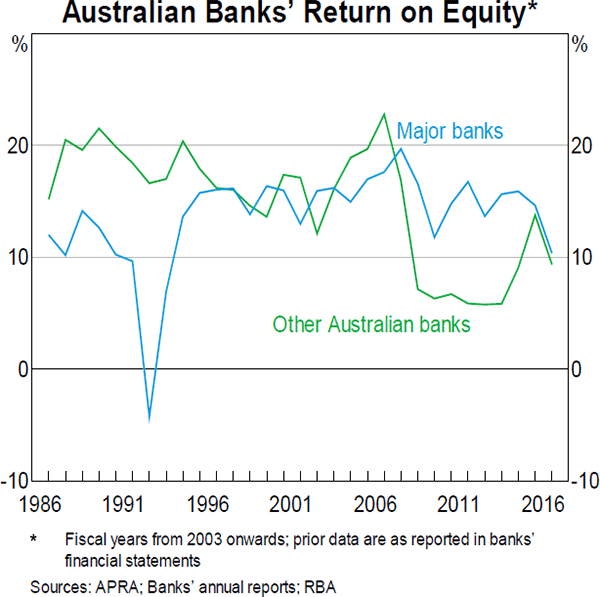
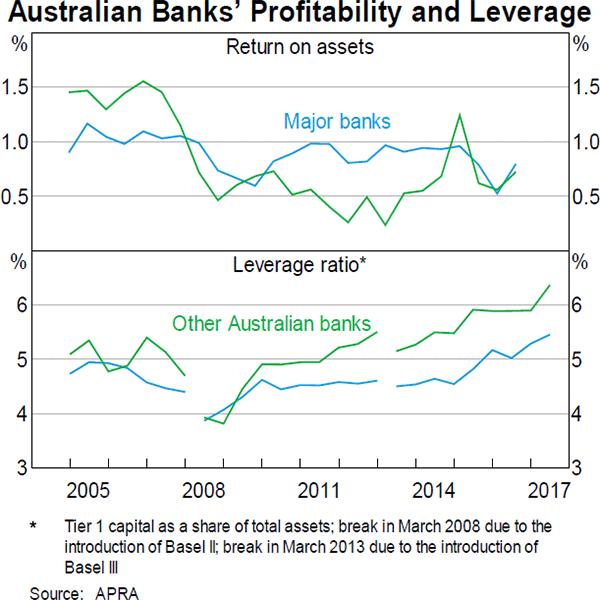
One factor explaining the divergence in ROE between the major banks and other banks over much of the past decade is capital levels or leverage (i.e. non-risk-weighted assets relative to capital, or inversely for the ‘leverage ratio’, capital to non-risk-weighted assets). While a number of regulatory measures have resulted in increased capital requirements for the major banks over recent years, smaller Australian banks have nonetheless still operated with a higher leverage ratio (i.e. higher capital) than the majors since around 2008 (Graph 10). This places downward pressure on smaller banks' ROE (Atkin and Cheung 2017). This higher leverage ratio partly reflects the fact that the smaller banks' assets carry a higher average regulatory risk weight (requiring them to hold more capital to meet the same risk-weighted capital ratio). This, in turn, partly reflects use by the major banks (and Macquarie Bank) of the internal ratings-based (IRB) approach to credit risk, which allows them to use their own models to determine risk weights. The smaller banks use the ‘standardised’ approach, which generally results in higher risk weights.[5] The average mortgage risk weight under the IRB approach was increased in 2016 to narrow the gap between the IRB weights and the standardised mortgage risk weights.[6] In addition to meeting an FSI recommendation (aimed at improving competitive neutrality), this has enhanced the resilience of ADIs using the IRB approach and aligns with the direction of work being undertaken by the Basel Committee on Banking Supervision (APRA 2015).
In addition to leverage, banks' ROE is determined by how effectively they generate returns from their asset base – measured by return on assets (ROA) (Graph 10). This measure of profitability also shows higher returns for the major banks for most periods since the financial crisis compared with smaller financial institutions. This could reflect both funding cost differentials and a different asset mix.
The major banks have been able to achieve lower funding costs than other banks (see the ‘Recent Influences on the Competitive Environment’ chapter). This partly reflects their structure and scale but it could also reflect investors' perceptions of an implicit government guarantee.[7] The ratings agencies have given the four major banks (as well as Macquarie Bank) an uplift to their credit ratings to reflect the perceived likelihood of government support in times of distress. Any uplift to smaller banks' ratings has been minimal or non-existent.
Another factor affecting ROA is the composition of assets on banks' balance sheets. For example, business lending is typically riskier than housing lending but can generate higher returns. Since the financial crisis the composition of banks' balance sheets has changed noticeably, with the share of housing lending increasing at the expense of other lending (Graph 11).
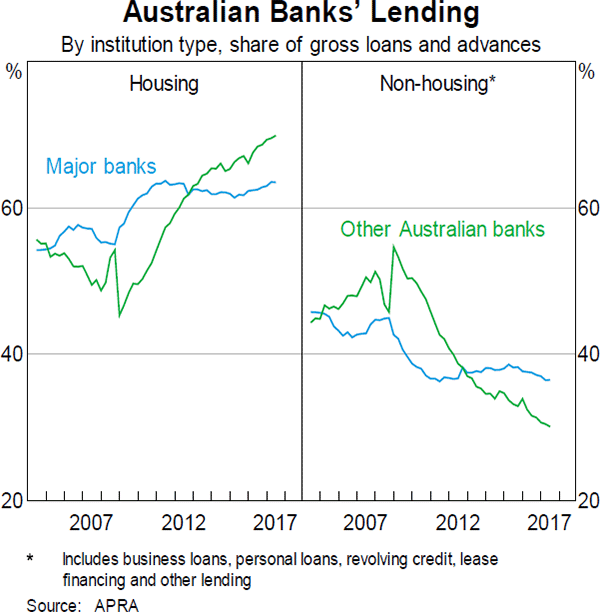
Margins
Net interest margin (NIM), which reflects the difference in banks' average lending and borrowing rates, provides an indication of the profitability of banks' lending activities, and so can shed some light on the degree of competitive pressure banks face.
The major banks' NIM declined sharply in the decades following deregulation and leading up to the financial crisis, consistent with rising competitive pressures (Graph 12). Since then, there have been significant changes to both the composition of banks' assets and funding, and the interest rates that apply to them. Nonetheless, the overall interest margin has remained relatively stable. While the major banks have had lower funding costs than smaller ADIs and higher returns on some loan assets over this period, they have at the same time increased their holdings of relatively low-yielding liquid assets, partly in response to regulation (Debelle 2015).
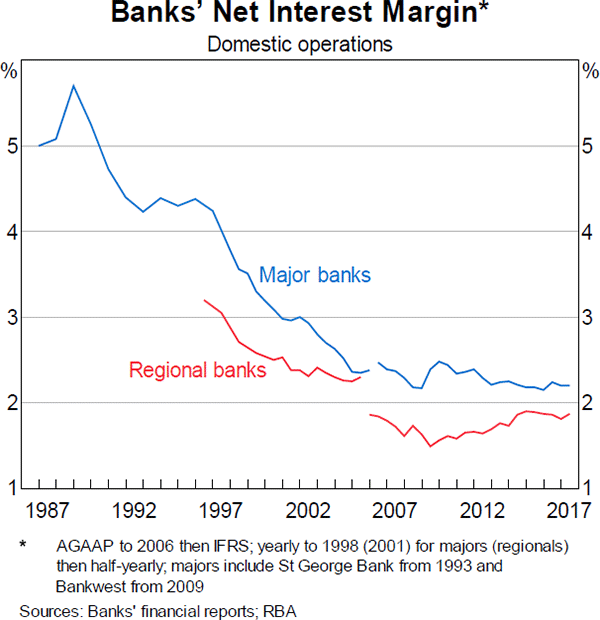
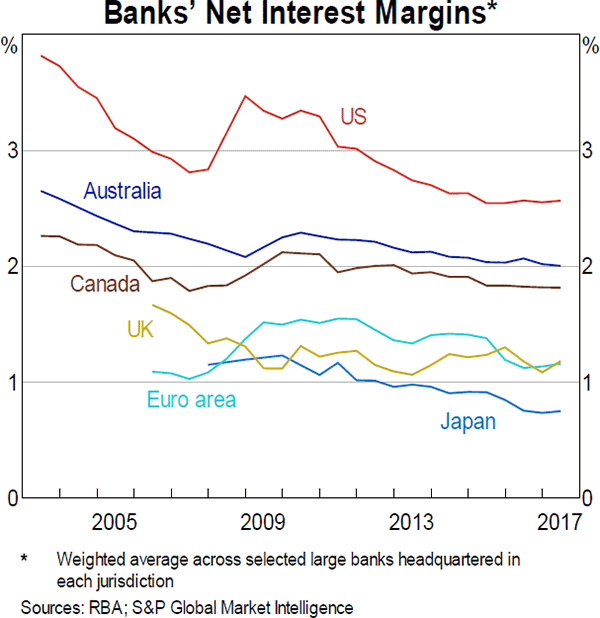
In contrast to the relatively stable NIM of the major banks, regional banks have increased their NIM in recent years, partly reflecting a decrease in their funding costs. Many banks are expecting an increase in their NIM as a result of increases in housing lending rates to investors and interest-only borrowers in recent months.
Australian major banks' NIM is in the range of the large banks in other countries and is close to that of Canada's large banks, which have similar asset and funding compositions to Australia's major banks (as well as a similar level of concentration)(Graph 13). It is nonetheless higher than European and Japanese banks. Once again, however, international comparisons need to be treated with some caution, because differences can reflect a range of factors, including the types of funding used and the riskiness and performance of loans granted.
Narrower measures of profitability, such as the spreads of lending rates to the cash rate, have shown divergent trends in recent years (Graph 14). Over the past few years, the spread on large business lending has declined as competition has emerged from foreign banks. However, the average spreads on small business and housing lending have risen as lenders have increased interest rates to control the flow of lending to some borrowers and to recover the costs of higher capital holdings.
While spreads on variable-rate home loans have been rising, once discounts are factored in, the rates offered by Australian banks are within the range of those in other advanced economies (Graph 15).[8]
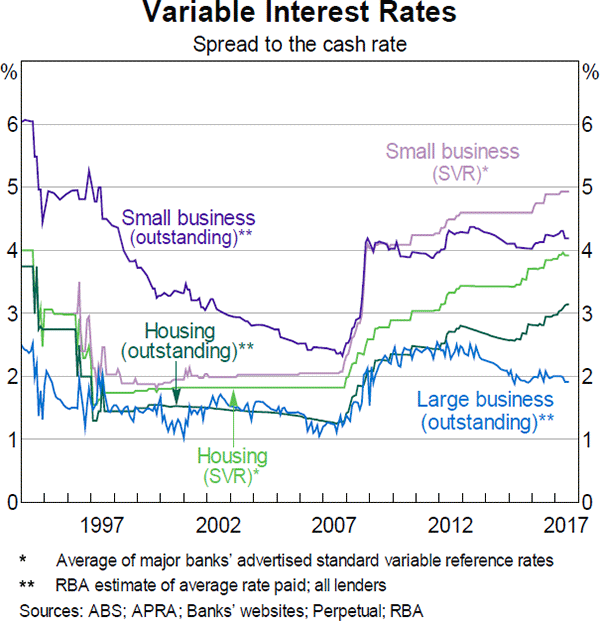
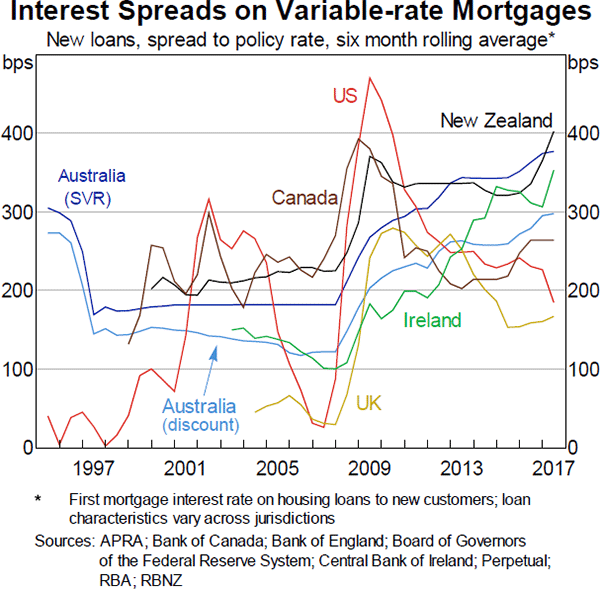
Footnotes
For more information on longer-term trends in the financial system, see (RBA 2006). [2]
Variation in banks' cost-to-income ratios can also reflect differences in banks' margins and pricing power. Cost-to-asset ratios do not suffer from this drawback. [3]
For more information on developments in the cost-to-income ratios of the major Australian banks, see (RBA 2014a). [4]
For example, the average risk weight on the major banks' IRB residential mortgage exposures was less than 20 per cent prior to September 2016 (at June 2017 this had increased to 25 per cent, see below) compared with an average risk weight of around 40 per cent on exposures measured under the standardised approach at all banks. [5]
For more information on regulatory measures on residential mortgages in Australia, see (RBA 2015a). [6]
Investors may accept lower returns for the credit risk associated with lending to institutions that they perceive as being systemically important. This is because of the likelihood that these institutions would receive government support in the event of distress. [7]
Interest margins on variable-rate housing loans are often not directly comparable, in part because the typical mortgage product differs across countries and the size of discounts to posted rates is often unobserved. Moreover, the features offered on mortgages can differ significantly across countries. For example, loans with redraw facilities and flexible repayment structures are common in Australia but are relatively scarce in most European countries. [8]